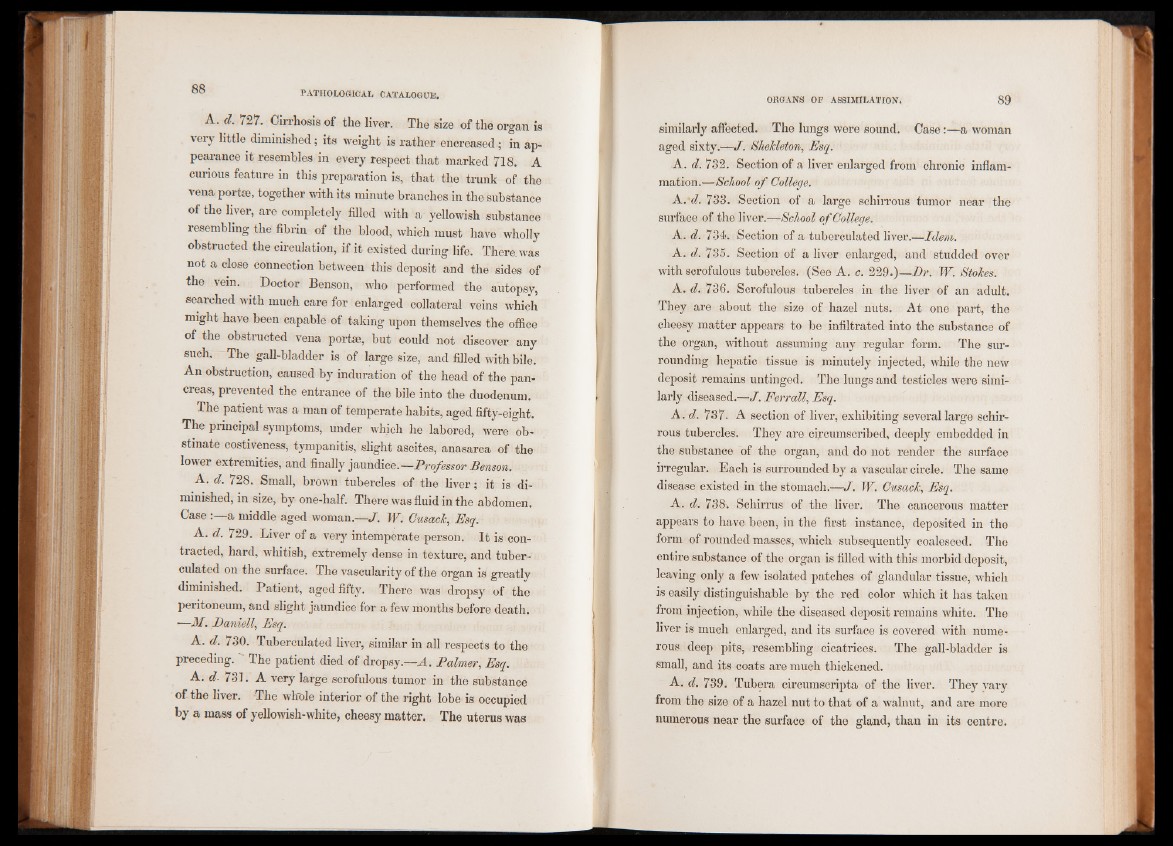
A. d. 727. Cirrhosis of the liver. The size of the organ is
very little diminished; its weight is rather encreased; in appearance
it resembles in every respect that marked 718. A
curious feature in this preparation is, that the trunk of the
vena port®, together with its minute branches in the substance
of the liver, are completely filled with a yellowish substance
resembling the fibrin of the blood, which must have wholly
obstructed the circulation, if it existed during life. There, was
not a close connection between this deposit and the sides of
the vein. Doctor Benson, who performed the autopsy,
searched with much care for enlarged collateral veins which
might have been capable of taking upon themselves the office
of the obstructed vena portae, but could not discover any
such. The gall-bladder is of large size, and filled with bile.
An obstruction, caused by induration of the head of the pancreas,
prevented the entrance of the bile into the duodenum.
The patient was a man of temperate habits, aged fifty-eight.
The principal symptoms, under which he labored, were obstinate
costiveness, tympanitis, slight ascites, anasarca of the
lower extremities, and finally jaundice.—Professor Benson.
A. d. 728. Small, brown tubercles of the liver; it is diminished,
in size, by one-half. There was fluid in the abdomen.
Case :—a middle aged woman.—J. W. Cusack, Esq.
A. d. 729. Liver of a very intemperate person. It is contracted,
hard, whitish, extremely dense in texture, and tuber-
culated on the surface. The vascularity of the organ is greatly
diminished. Patient, aged fifty. There was dropsy of the
peritoneum, and slight jaundice for a few months before death.
—M. Daniell, Esq.
A. d. 730. Tuberculated liver, similar in all respects to the
preceding. " The patient died of dropsy.—A. Palmer, Esq.
A- d. 731. A very large scrofulous tumor in the substance
of the liver. The whole interior of the right lobe is occupied
by a mass of yellowish-white, cheesy matter. The uterus was
similarly affected. The lungs were sound. Case:—a woman
aged sixty.—-./. Shekleton, Esq.
A. d. 732. Section of a liver enlarged from chronic inflammation.—
School of College.
A.‘d. 733. Section of a large schirrous tumor near the
surface of the liver.—School of College.
A. d. 734*. Section of a tuberculated liver.—Idem.
A. d. 735. Section of a liver enlarged, and studded over
with scrofulous tubercles. (See A. c. 229.)—Dr. W. Stokes.
A. d. 736. Scrofulous tubercles in the liver of an adult.
They are about the size of hazel nuts. At one part, the
cheesy matter appears to be infiltrated into the substance of
the organ, without assuming any regular form. The surrounding
hepatic tissue is minutely injected, while the new
deposit remains untinged. The lungs and testicles were similarly
diseased.—J. Ferrall, Esq.
A.d. 737. A section of liver, exhibiting several large schirrous
tubercles. They are circumscribed, deeply embedded in
the substance of the organ, and do not render the surface
irregular. Each is surrounded by a vascular circle. The same
disease existed in the stomach.—J. W. Cusack, Esq.
A. d. 738. Schirrus of the liver. The cancerous matter
appears to have been, in the first instance, deposited in the
form of rounded masses, which subsequently coalesced. The
entire substance of the organ is filled with this morbid deposit,
leaving only a few isolated patches of glandular tissue, which
is easily distinguishable by the red color which it has taken
from injection, while the diseased deposit remains white. The
liver is much enlarged, and its surface is covered with numerous
deep pits, resembling cicatrices. The gall-bladder is
small, and its coats are much thickened.
A. d. 739. Tubera circumscripta of the liver. They vary
from the size of a hazel nut to that of a walnut, and are more
numerous near the surface of the gland, than in its centre.